Home Film My Art
Art
Other: (Travel, Rants, Obits)
Links About
Contact
Stan Brakhage links page Stan Brakhage stills page
This review of the last films completed by Stan Brakhage before his death on March 9, 2003 appeared in the Chicago Reader on May 16, 2003, both the print edition and the Web site, under the title Scenes From the Afterlife. I post it here with a few small additions, and many color frame enlargements. Fred Camper
All images from Brakhage films here are reproduced by permission of the Estate of Stan Brakhage and may not be reproduced elsewhere, including on the Internet, except by permission of Marilyn Brakhage (email her at vams@shaw.ca). Once permission has been arranged, email me for higher resolution files.
The images below are placed from left to right in the order in which they appear in the film. Note that the strips show more of the image's edges than is seen on the screen; projectors are designed to crop the image slightly, and I replicate the standard degree of cropping when I post single frames. Most importantly, most of the images appear in the films for only 1/12th or 1/24th of a second; at twelve different compositions per second, the eye can't wander around in the richly detailed paintings as it can in stills, and these paintings' fleeting, apparition-like quality and the films' jittery collisions of images are keys to Brakhage's aesthetic.
Frame enlargements from Panels for the Walls of Heaven (below) and Max (right), by Stan Brakhage:
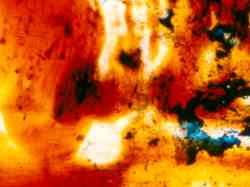
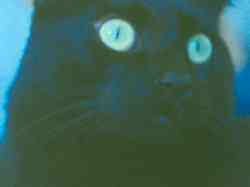
A Review of Stan Brakhage's Last Films
By Fred Camper
Last year, after the return
of the cancer that would cost him his life in March, Stan Brakhage told me
in a phone conversation that he'd just completed two films,
Ascension and Resurrectus Est; I knew he was also
working on a longer film, Panels for the Walls of Heaven. Knowing
that he hadn't lost his sense of humor, I said, "Stan, I don't like the
way these titles are sounding. When we talk again, I want to hear that
you're working on a film titled `The Next Ten Years.'" He chuckled, then
said, "The thought of living for another ten years horrifies me." He went
on to say that he'd always been ambivalent about life. While other
evidence suggests that he really did want to go on living, his comment has
resonated with me as a key insight into his career, which spanned 50 years
and close to 400 films.
Brakhage's ambivalence about existence can be seen in his early film
dramas, in which agonized individuals strain against imagined prisons; it
can be seen in his first major work, Anticipation of the Night
(1958), a testament to the failure of imaginative seeing, ending in the
protagonist's suicide; it can be seen in the cosmic deconstruction that
concludes the four-hour The Art of Vision (1965); it can be seen in
what is perhaps his greatest achievement, the "Arabics," a series of 19
abstract films that are both glorious examples of light in motion and
unsettling documents of seeing so "abnormal" that the viewer feels almost
disoriented. And it can be seen in his five final completed works, being
shown at the Film Center May 20 in a "Tribute and Benefit" to assist his family with the
costs of his final illness. Four of the five are Chicago premieres (the
2001 Jesus Trilogy and Coda is not), and this is only their fourth
public showing anywhere. (The two works left unfinished at his death are
being completed by former students and will soon be released.)
Taking defiance of filmic forms to a new extreme, these works have
qualities often found in an artist's late oeuvre. Brakhage refines his art
to its essence, to an unpredictability that's nevertheless not random,
neither borrowing from drama as in his earlier films nor supplying the
potent symbolism of such late hand-painted works as The Dark Tower.
The last four films in particular have an austere, almost autumnal visual
and emotional evenness. All but one of the four — Max is the
exception — were made by painting directly on the 16-millimeter film
strip one frame at a time, and their shifts in perspective keep the viewer
on edge to an almost delirious degree. Because each frame takes only one
twenty-fourth of a second, Brakhage often chose to repeat each one two,
three, or four times in the printing, resulting in between 6 and 12 images
per second. At this speed, each painting is visible just long enough to be
perceived in some detail but not long enough to become a static picture.
The resulting tension between stills and implied movement is only one of
the many ways Brakhage sets the viewer off balance.
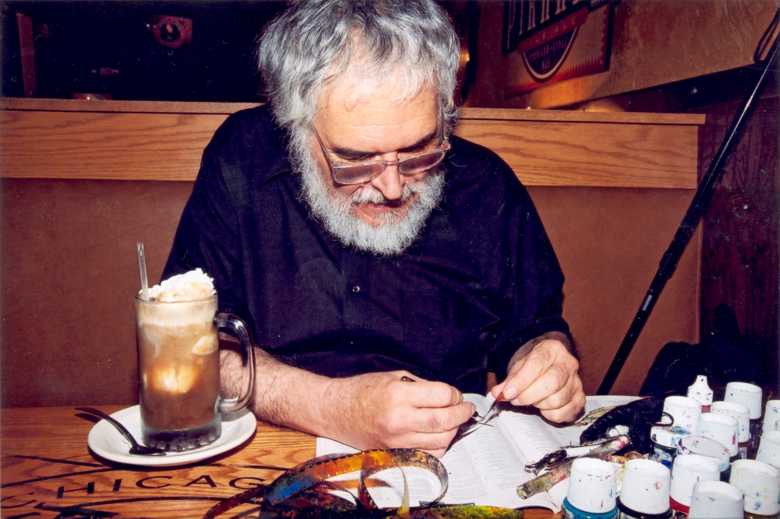

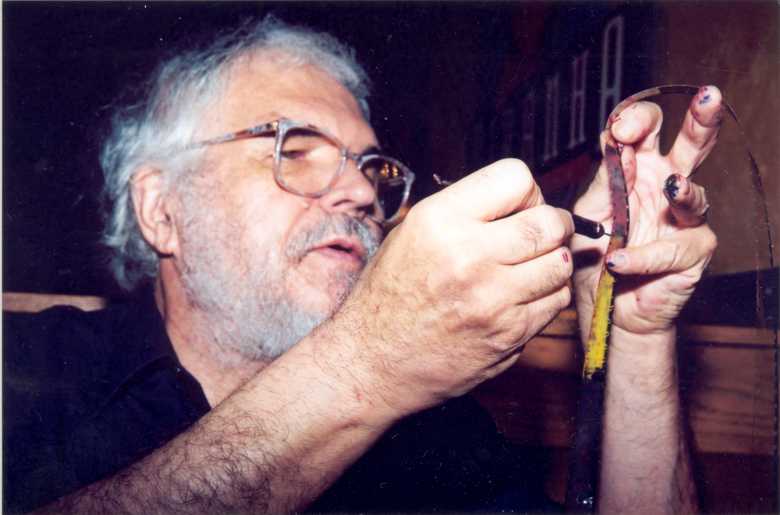
Stan Brakhage painting on film in a Boulder cafe, 2002, photographed by Kai Sibley, copyright © Kai Sibley 2002. If you wish to reproduce these, and other portraits of Brakhage by Kai Sibley that I have available, please write to Kai Sibley. With her permission, I can make larger and higher-resolution versions available for download..
These films are as sensuously spectacular as his previous works,
beautiful accretions of color. Contrasts heighten the impact of each
instant: Brakhage makes a sharply textured red pierce a fuzzier blue
within a composition, in superimposition, or in editing — only one of a
thousand dynamic clashes that intensify our seeing, as if scouring out the
vision. These contrasts give the spectator an active role — each film is
an "adventure in perception," as Brakhage put it at the opening of his book, Metaphors on Visions. His speculation about
the prelinguistic seeing of children is just one example of a more general
interest in alternatives to functional vision, the kind we need in order
to walk across a room without bumping into things. Still in search of
alternatives, these films are if anything more extreme than Brakhage's
earlier work: no single look or rhythm dominates.

Brakhage said late last year that he tried to choose titles to "open
people to seeing the film." Yet the title of the longest film on the
program, the 31-minute Panels for the Walls of Heaven, seems almost
false advertising: it looks nothing like static panel paintings and never
reaches stasis — a major part of its point. More than halfway through the
film an image is held for several seconds, but this is a dynamic event, a
surprise because the picture lasts more than the expected fraction of a
second; significantly, the image Brakhage chooses to hold is mostly
black.
Panels for the Walls of Heaven is the fourth and last of the
"Vancouver Island" films, all of which present Brakhage's imaginary
biography of his second wife, Marilyn. Brakhage said in a videotaped
introduction he made in January for this program that his film does not
aim to be "worthy of heavenliness"; rather, it's an "imagination of same."
And the viewer might be hard-pressed to see any conventional heaven here
— not only are there no recognizable pictures, there isn't even a single
mood. Hating symmetry, avoiding all forms of predictability, Brakhage
produces compositions that are off center, weighted toward one area as if
ready to tip over. And each image does tip over, very rapidly, into the
next, yielding to its successor.
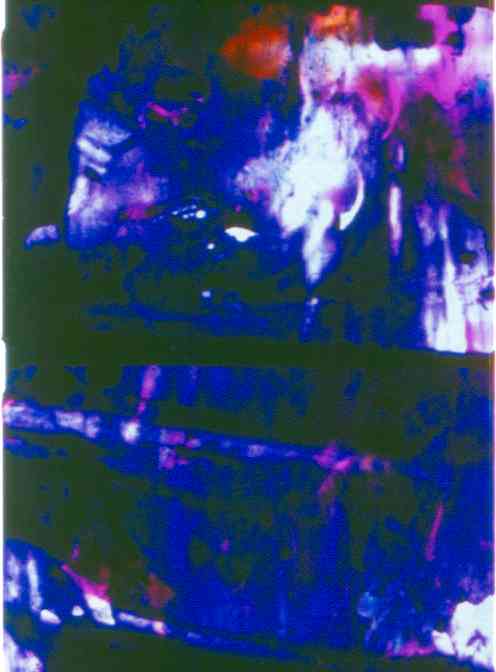

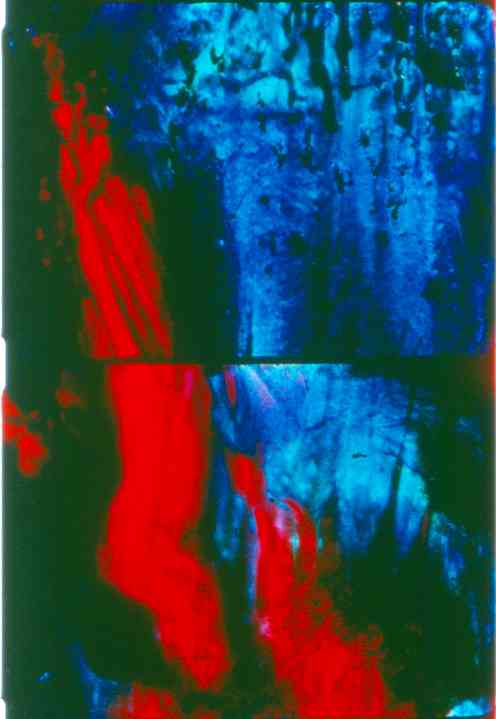

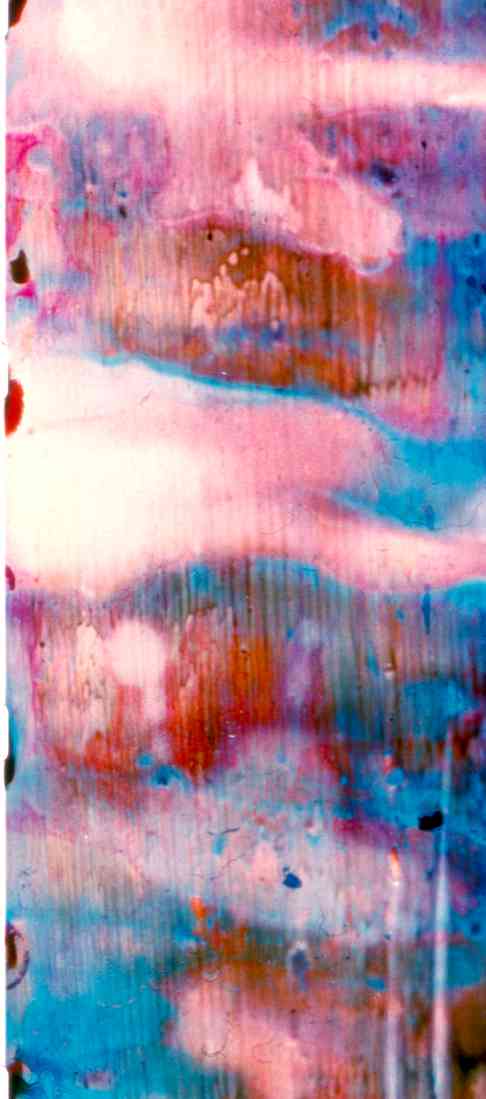
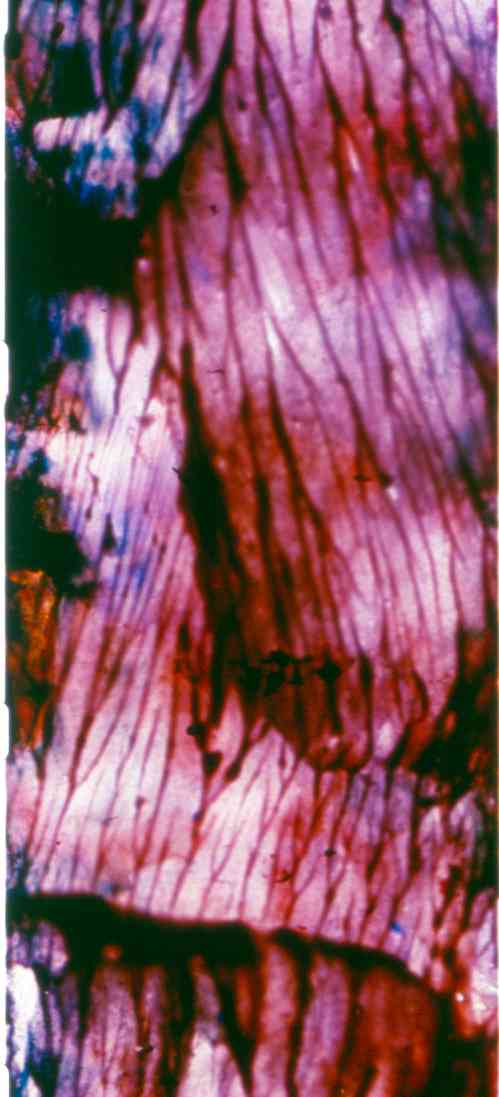
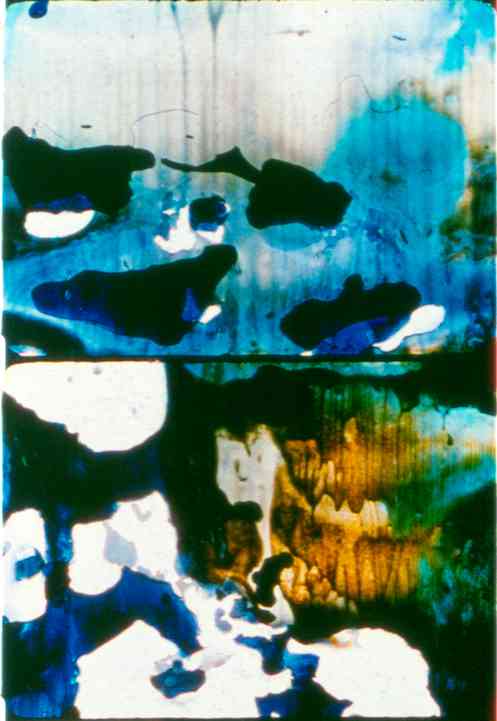
[Frame enlargements from Panels for the Walls of Heaven, by Stan Brakhage. These and the other images on this page appear from left to right in the order in which they appear in the film. For those sections of the film in which each frame is printed two or more times, I've shown only two adjacent frames, to show the cut. For two strips in which every frame is different, I've included three frames. Please also note that the strips show more of the image's edges than is seen on the screen; projectors are designed to crop the image slightly.]
The sheer variety of images in Panels for the Walls of Heaven
creates a labyrinth of possibilities. Spots of color pierce the darkness;
transparent washes are drawn over white as if painted on glass; textures
vary, from areas of color rendered in parallel lines like brush strokes to
soft, even fields to mottled patterns of multiple similar shapes. At times
the texture of the paint is sharply visible, at other times intentionally
thrown out of focus in the printing. There are suggestions of glowing rock
caves, of ice caves, of very near surfaces, and of distant clouds. Often
different types of images are overlaid; superimposing sharp paintings on
out-of-focus ones is particularly striking, suggesting an alternative way
of seeing the sharp ones. And the rhythms of the images vary, from rapid
staccato bursts to continuously dancing forms to sudden decelerations
lasting a mere fraction of a second. Brakhage's imagined heaven is an
unceasing dance with light.
The emphasis on unpredictability prevents the film from having a
readily graspable structure. Instead it lives and breathes in its
instants, as the viewer reinvents seeing at each moment of its unspooling.
Brakhage seeks not spectacular pictures — certainly not to the extent he
did in some earlier work — but constant change, making one question the
very nature of existence. Pushing his films almost to the point of chaos
and denying the viewer images from the world we know, he creates the sense
of teetering on a brink, of consciousness suspended over a void by the
slenderest of threads.
Brakhage achieves an exquisite balance between opposites, between
organizing light over time in a manner worthy of the classical music that
inspired him and pulling apart the raw stuff of the world into near chaos.
More extraordinary, he fuses these opposites: we feel both impulses at
once and experience them as reconciled. Yet freeing vision from cultural
expectations seems to entail abjuring the continuous self, producing a
death song of sorts. Underlying Brakhage's flirtation with chaos is a
philosophical question: How much freedom from convention is it possible to
achieve and still go on living in the world?

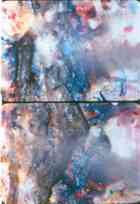
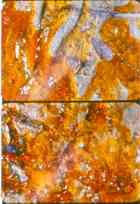
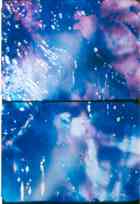
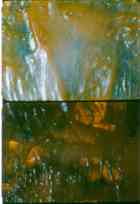
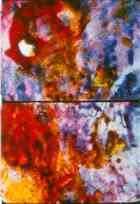
[Frame enlargements from Ascension, by Stan Brakhage, in the order in which they appear in the film, starting with the first two images, which are shown in the strip at far left. In these strips, each frame is printed twice, so in showing two different frames I am also showing a "cut."]
The shorter films on the program are no less spectacular or profound.
Ascension begins by superimposing paintings that look like clouds
over extremely close views of mottled paint, peculiarly intimate in their
three-dimensionality. Juxtaposing images of transcendence with
representations of what he liked to call the "mess" of life, Brakhage
distances himself from both.
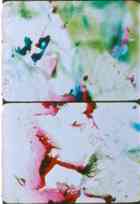

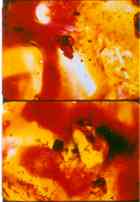

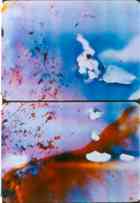
[Frame enlargements from Resurrectus Est, by Stan Brakhage, in the order in which they appear in the film, starting with the first two images, which are shown in the strip at far left. In these strips, each frame is printed twice, so in showing two different frames I am also showing a "cut."]
In Resurrectus Est, he sets complex
fields of paint and color combinations against a largely white background.
Near the end, the paintings become separated by longer and longer
stretches of white. Brakhage once said he wanted to "leave a snail's trail
in the moonlight," and these splotches of paint against white seem
acknowledgments of a certain humility new to him.

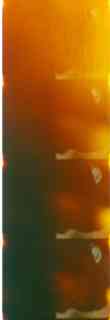
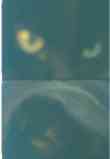

[Frame enlargements from Max, by Stan Brakhage. The strip at left is from near the film's opening; at right, from near the very end.]
The one work made with a movie camera, Max, grew out of
Brakhage's desire to create a record of his cat. After several attempts,
he was finally satisfied with a single roll, edited in camera. He used to
complain that viewers didn't understand that he had a sense of humor, but
often his humor is subtle, revolving around individual oddities, whether
of humans or animals — a body or face or eye that stands out from a more
even field of light. Because for Brakhage light stands for the energy
underlying all things, sometimes it seems that locking it into a
recognizable or namable shape is too restrictive. Max jokes about
this issue by making the cat's individuality seem odd, as its bright eyes
occasionally peer out from a mass of soft-focus fur, markers of a being
that almost seems to understand its own insignificance.
Best known as an advocate of individual vision in film, Brakhage by the
middle of his career was starting to shift his definition of self away
from "personality" and toward a more expansive sort of consciousness. At the film's beginning, Max appears out of the yellow-red flares that are caused by light fogging at the beginnings and ends of film rolls; at the end, Max vanishes into those same flares, so that her presence is subsumed by a yellowish fog. Though this effect is often seen in single camera roll films, here it combines with the oddness of Max's presence and the delicacy of Brakhage's compositions to make a point about the fragility and temporariness of the film image, about its roots in pure light. And at the end, it seems as if the filmmaker uses the cinematic process to say good-bye to us — and to all the things of this world.
Goodbye, Stan.
Copyright © Fred Camper 2003
All images from Brakhage films here are reproduced by permission of the Estate of Stan Brakhage and may not be reproduced elsewhere, including on the Internet, except by permission of Marilyn Brakhage (email her at vams@shaw.ca). Once permission has been arranged, email me for higher resolution files.
Stan Brakhage's films are available for rental
from the Film-Makers' Cooperative, Canyon Cinema, and other distributors.
Chicago Reader Links:
Reader Homepage |
On Film Main Screen |
Archive of Long Reviews |
Archive of Brief Reviews |
Critic's Choices |
Showtimes |
Stan Brakhage links page Stan Brakhage stills page
Home Film My Art
Art
Other: (Travel, Rants, Obits)
Links About
Contact
























